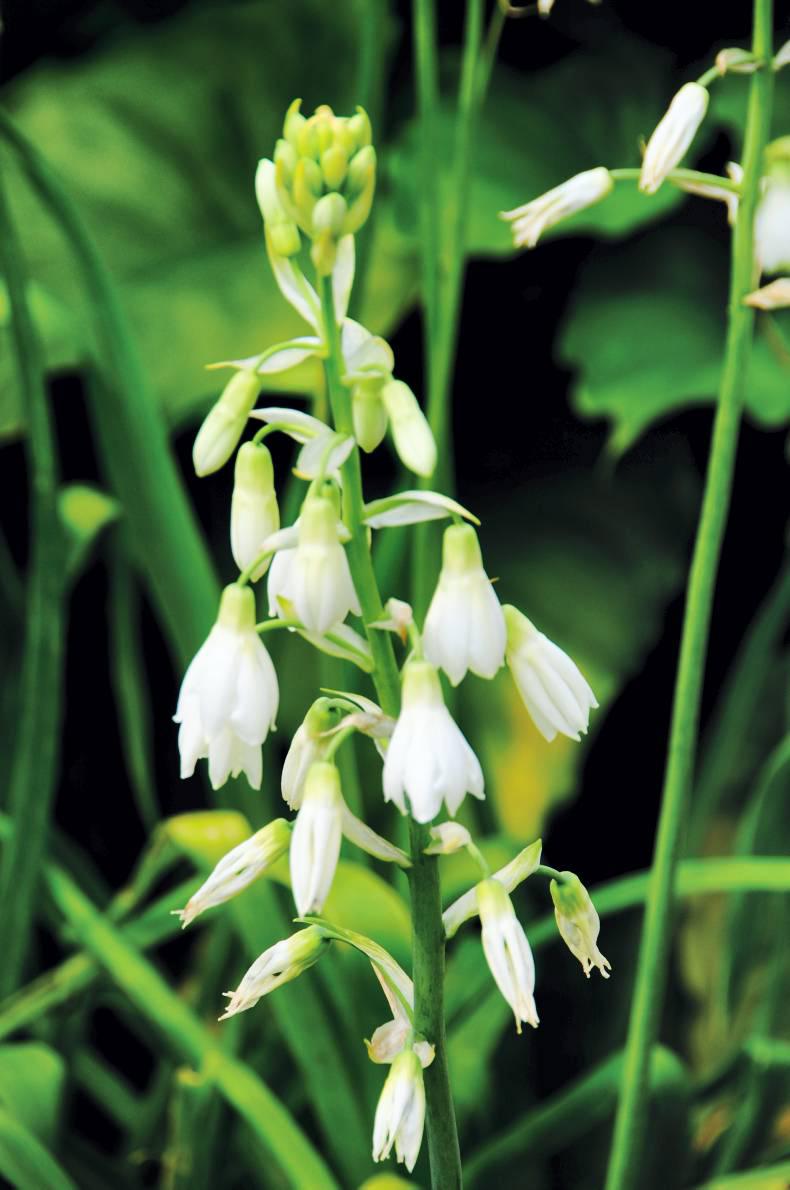The summer hyacinth or galtonia is a splendid flower in late summer for bringing a fresh newness to a border – just as so many plants that flowered earlier are beginning to tire and fade away, such as poppies, irises and peonies, the stalwarts of early summer. Not that galtonia provides a replacement for those excellent flowers, but it does help in its own quiet way. And it is that quality of quiet elegance that recommends this flower for use. It adds a touch of style right away, much in the way that blue-flowered, or white-flowered camassia does in early summer. This is not a coincidence because the two plants are related, both members of the hyacinth family, which itself is part of the greater lily family. Summer hyacinth is from South Africa, while hyacinths are from Central Asia.
Its botanical name is Galtonia candicans, the second part of the name meaning white. The botanical name is a better one because, although related, it is misleading to use the name summer hyacinth. Hyacinths are spring plants and the galtonia has only a distant family resemblance. Galtonia is much taller, making the hyacinth look dumpy by comparison, and it reaches to over one metre, sometimes 1.2 metres in good soil when well suited. It is the height that lends the flower a stately bearing. The leaves that appear before the flower spike are tall, too, and decorative in their own right, with an appealing soft greyish-green colour and great lushness of growth. The flower spike quickly shoots up from the large bulb through the rosette of leaves.
The flower stem carries about twenty flowers. These are white, starting from green buds and retaining a touch of green at the point where it connects to the arching flower stalk that is attached to the stem. The slender stalks hold the 5cm flowers in pendulous fashion, the nodding arrangement of the flowers accentuating its elegant standing. The white colour, including the tinge of green, is cooling, and galtonia can be combined with hot colours: reds, yellows and purples, and bronze or purple foliage that need cooling, or to enhance the lightness of paler colours: pinks, light blue and grey or silvery foliage. It could be used in both instances to act as a linking plant, bringing some unity to a mixture of hot and cool colouring.
Being quite a large, lush plant that shoots to over a metre in a few months, it is not a surprise that it needs good conditions to grow well. It is not tricky to grow, in fact, it nearly always succeeds in flowering even in conditions that are not ideal, but it is such an impressive plant that the objective is to get the best out of it. It likes good fertile soil, to which organic matter has been added over the years, or can be. It does not like heavy soil, and the soil must be well-drained but not dry out during the period of rapid growth in spring and summer. Most gardens have places that would suit the bulbs very well. While a single plant is handsome, galtonia looks best as a group of several stems towering upwards. Also, it is much better if there are several groupings in the same border or the same garden, for a wonderful effect between July and September. It is hardy but the bulbs may suffer in a severe winter unless covered with an insulating layer of compost or soil. CL
Nice weather for vegetables
Although spring was cold and late, and it was difficult to get an opportunity to sow vegetable seeds, growth has been very good since early May with a mixture of showers and sunshine. While this kind of weather does not suit human outdoor activity, it suits plants perfectly. There was a dry spell in early June but there has been rain when needed by vegetables. Growth of peas and French beans is remarkable, broccoli from a 22 April sowing has been picked, as with carrots and summer turnips, sown direct into a good seed bed. Radish and rocket have long since been used or gone to seed. Photo shows a turnip pulled on 13 July.
Fruit, vegetables and herbs
Repeat sow salad vegetables that mature quickly, as well as peas and leaf spinach. Weed control should be kept up to prevent them from going to seed and causing trouble in the years to come. Spray apple and pear trees for scab diseases if the trees were affected in other years. Plant out winter cabbage and cauliflower.
Lawn
After a slow start due to a cold spring, grass got going well during the spells of sunshine and rain. Lawns have been growing well and most show good colour, but if a lawn looks brown and tired, it could probably benefit from some high-nitrogen fertiliser put on with rain on the way. Trim lawn edges for a neat look.
Flowers
Seeds of perennial flowers, such as lupins, mallows and foxgloves could be sown now for flowering next year. Bedding plants in pots and baskets will be looking good now, but they are also in greater need of regular watering and feeding. Feeding every two weeks or so is essential to keep the plants going.
Trees, shrubs and roses
There is rose blackspot disease about and it is necessary to continue to spray rose bushes, especially in the damper parts of the country. Mildew has also appeared on susceptible rose varieties. Early flowering shrub roses and ramblers could be pruned by removing some of the shoots that flowered.
Greenhouse and house plants
Take cuttings of all kinds of shrubs now, using two parts peat to one part sand and covering with white polythene. Use rooting powder. Continue watering and feeding greenhouse plants. Be careful to water plants in pots or grow-bags regularly as these can easily dry out. Train and side-shoot tomatoes.






 This is a subscriber-only article
This is a subscriber-only article






SHARING OPTIONS: